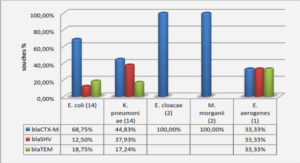LES PNEUMOPATHIES AIGUES COMMUNAUTAIRES
Patients’ selection and inclusion criteria
A retrospective study was carried out at university hospital in Angers, France. Medical informatic database was used to recruit patients hospitalised for CAP between January 2006 and December 2010 in respiratory diseases department, then patients’ paper-based medical records were analysed. According to French legislation, the agreement of an ethic committee is not required for retrospective collection of data corresponding to current practice.
Pneumonia was defined by the presence of infiltrate on chest radiograph associated with clinical evidences: cough, sputum, chest pain, crackles and fever [6, 12].
Complicated parapneumonic effusion (CPE) was characterized by LDH > 1000 IU/L in pleural fluid without any other criteria for empyema.
Empyema was characterized by purulent macroscopic aspect with majority of degenerated neutrophils or positive pleural fluid culture [10, 13].
Simple parapneumonic effusion (SPE) was defined by a pleural fluid without criteria of CPE.
Exclusion criteria were: Age < 18 years, hospitalisation in the preceding 21 days to exclude nosocomial pneumonia, cerebrovascular diseases with significant sequelae or previous laryngological surgeries to exclude aspiration pneumonia.
Population’s characteristics
A total of 439 patients with CAP were included in this study. Among 181 patients with pleural effusion on chest radiography, 121 were explored by thoracocentesis. We identified 20 SPE (4.5%) and 101 CPE (23%) including 84 empyemas following aforementioned criteria (19% of all CAP). The flow chart of patients is represented on Figure 1.
Demographic data and comorbidities are shown in Table 1. In group E, patients were significantly younger, with more frequent alcohol abuse, but less frequent cardiac disease. We observed no difference in any other comorbidity especially on COPD and tobacco status.Regarding current treatment, summarized in Table 2, ICS and SCS were significantly more frequent in group E, whereas we observed no difference in frequency of recent treatment with SCS or NSAID in both groups, neither in other current immunosuppressive therapy. Patients in group E had been more frequently treated with antipneumococcal antibiotics before hospitalisation.
Baseline patient’s characteristics
Clinical, biological and radiological characteristics are shown in Table 3. Inflammatory markers (CRP and leukocytes) at admission were significantly higher in patients of group E. We also observed a longer length of disease prior hospitalisation, and chest pain was more frequent at admission in this group. Empyema was associated with more frequent pulmonary abscess and loculated effusion. However, there was no difference in blood gases at hospital admission.Microbiologic diagnosis was positive in 205 cases, as shown in Table 4. Streptococcus pneumonia was the most frequent agent isolated in both groups, identified either in pleural fluid (n=14), blood cultures (n=39), sputum (n=4), or by urinary antigen (n=84).
|
-Introduction
-Article
-Introduction
-Material and methods
-Patient’s selection and inclusion criteria
-Data collection
-Statistical analysis
-Results
-Population’s characteristics
-Baseline patient’s characteristics
-Hospital management
-Analysis of factors associated with empyema occurrence
-Discussion
-References
![]() Télécharger le rapport complet
Télécharger le rapport complet





